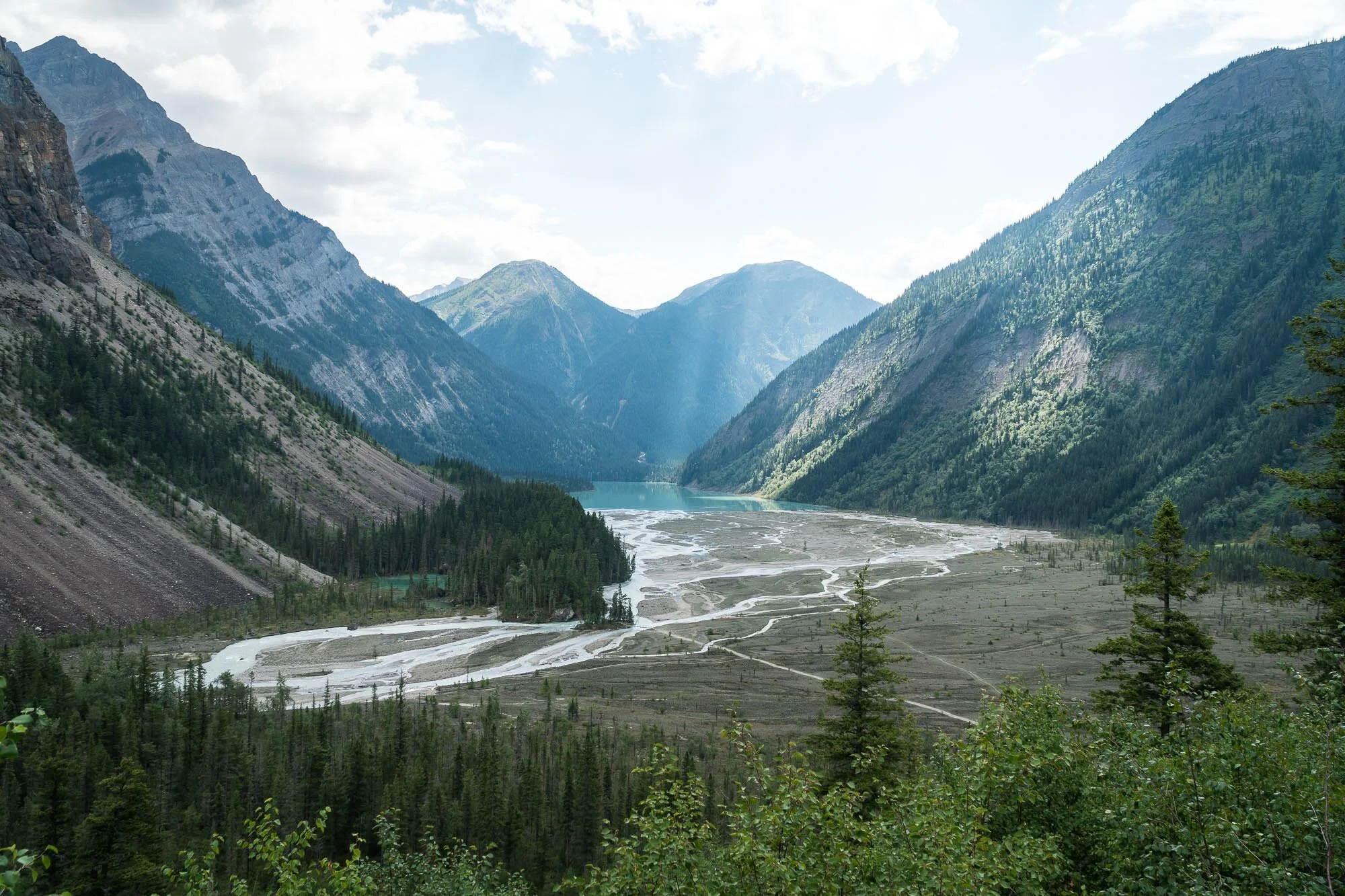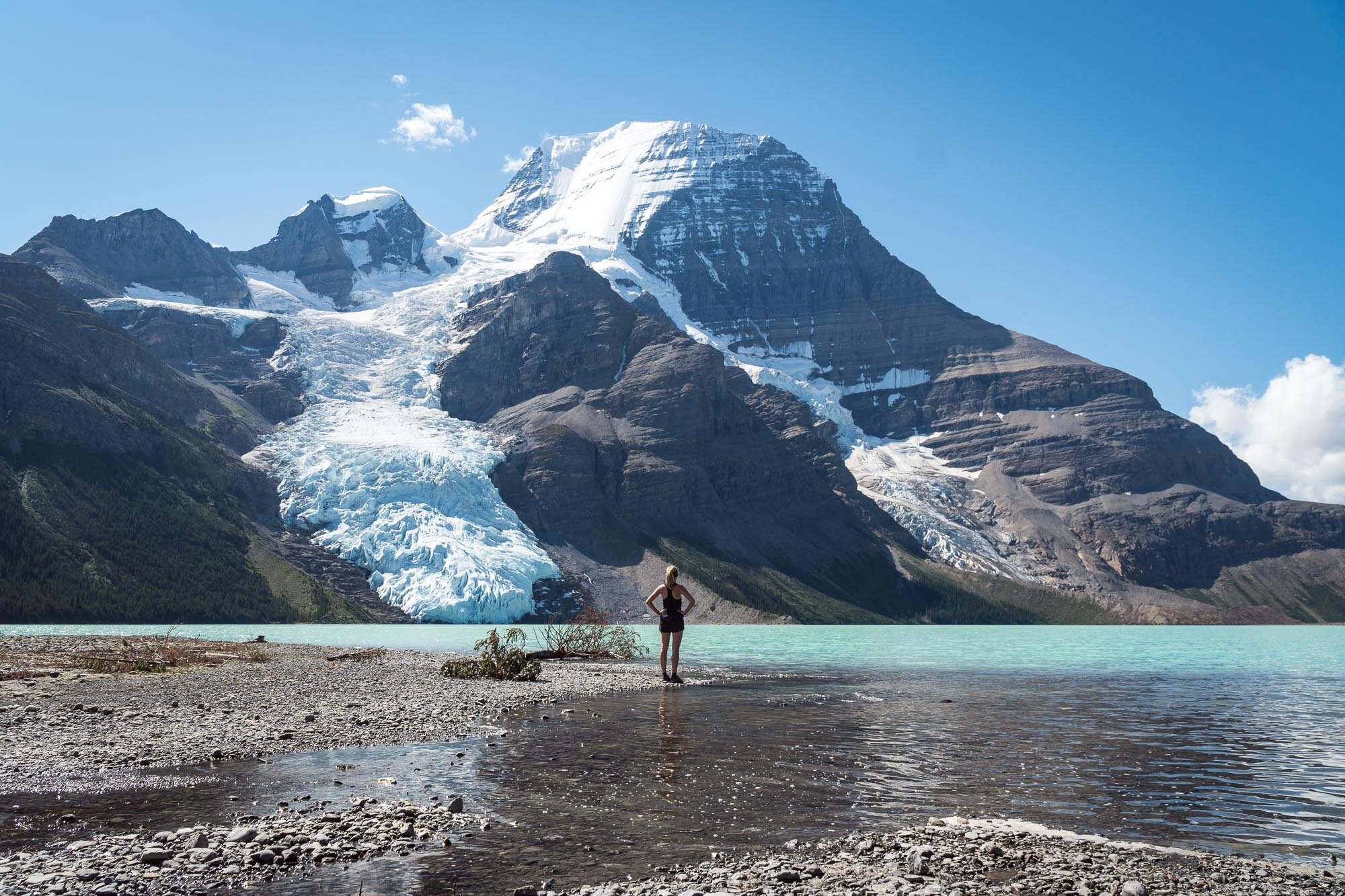Located in Mount Robson Provincial Park, the Berg Lake Trail is one of Canada’s premiere multi-day hiking trips and easily one of the top (easily accessible) hiking and camping destinations in all of the Canadian Rockies. The trail winds its way right next to the tallest mountain in the Canadian Rockies, Mt. Robson (3.954m high and UNESCO World Heritage site). It totals 23km one-way , gains 800 meters and includes 7 backcountry campgrounds, ranging from 5-23 camping spots at each location. At the top is the turquoise Berg Lake named for the large chunks of ice that calve from the 3 glaciers (Mist, Berg and Robson) that feed the lake.
As the trail is high on the list of many backpackers it is permitted to avoid overcrowding and overuse. Luckily we planned early enough and obtained a permit a couple of months prior to our trip through the BC park system. We arrived early at the visitor centre to check in and receive our backpacking permit. The 7 campgrounds along the trail are Kinney Lake (7km), Whitehorne (11km), Emperor Falls (16km), Marmot (19km), Berg Lake (21km), Rearguard (22km) and Robson Pass (23km). We managed to get a spot at Marmot for two nights, so a big day lay ahead.
The first 4.5km is an old gravel road right next to Robson River that climbs steadily uphill but is never steep. We were fascinated by the microclimate here! In fact, the rainforest found in the Robson Valley is the world’s most extensive inland rainforest. Following the trail up to Kinney Lake we passed some massive red cedars and hemlocks that are over 1200 years old, 3.5m in diameter, and 45m high. As the first part of the trail is fairly easy we saw a lot of families, bikers and day-hikers with dogs making their way up to Kinney Lake. Leaving the lake behind the trail became much smaller and less frequented. From here we really started to gain elevation as we climbed into the Valley of A Thousand Falls. There were a few nice viewpoints for various waterfalls as we climbed the valley, but the most impressive was Emperor Falls at the top.
After this point the trail started to level out a bit, and soon the views began to open up as we approached Berg Lake. As the trail wound around Mount Robson, it got closer and closer to us. It’s hard to actually describe the overwhelming feeling of the whole scenery. 8 hours after we started our hike we were excited to reach Marmot Campground at the southwest end of the lake before the sun was setting. After we finished exploring and filtering water, we ate dinner and set up our tent. It didn’t take long until it got pretty cold, and we didn’t last long once the sun dipped behind the mountains.
After a peaceful night we enjoyed our breakfast right at the lake and eventually packed up to head towards Snowbird Pass. As we started a little late we didn’t expect to do the whole hike and had another stop at Berg Lake campground to enjoy the scenery. Standing at the shore it’s hard to believe the first time you see it. Berg Lake and Mount Robson just look like they belong on a postcard.
Still unsure how far we’d hike that day we continued through the meadows of the Berg Lake Valley, following the silt-laden water up to its source at the small, glacier-fed Robson Lake. The trail started to become more difficult as it climbs to the top of a glacial moraine. At this point, we were already at the far end of Robson Lake, amazed by the pure size of Robson Glacier up close and straight ahead. We met a group of hikers coming back down from Snowbird Pass and chatted for a bit to evaluate how far we could make it and if it was worth going all the way up. The answer was obvious. So there we went – another 23km with 800m elevation gain in difficult terrain, initially thinking we had tired legs from the day before.
Climbing steadily we crossed a wide meadow with lots of active marmots and started our final push to reach Snowbird Pass in the late afternoon. The scenery was stunning and of course it was all worth it! We were awarded with spectacular views of the Robson Glacier, a beautiful alpine valley, and the enormous Reef Icefield beyond the pass. Looking across the vast expanse of ice separating British Columbia and Alberta, we took a well-deserved rest and quietly contemplated our achievement.
After the elation, the sobering reality of the long return hike to the campsite. We traced the same route back through the lush green valley, then descending the rocky mountain slope to the foot of Robson Glacier in the setting evening sun. Ten hours after we had set out on our trek, we returned to Marmot, had a quick dinner with our headlights on and snuggled up in our sleeping bags before the big descent the next morning. We were exhausted but the exhilaration of completing this beautiful and challenging route made this day feel like another spectacular adventure we’ll always remember.






































































































































